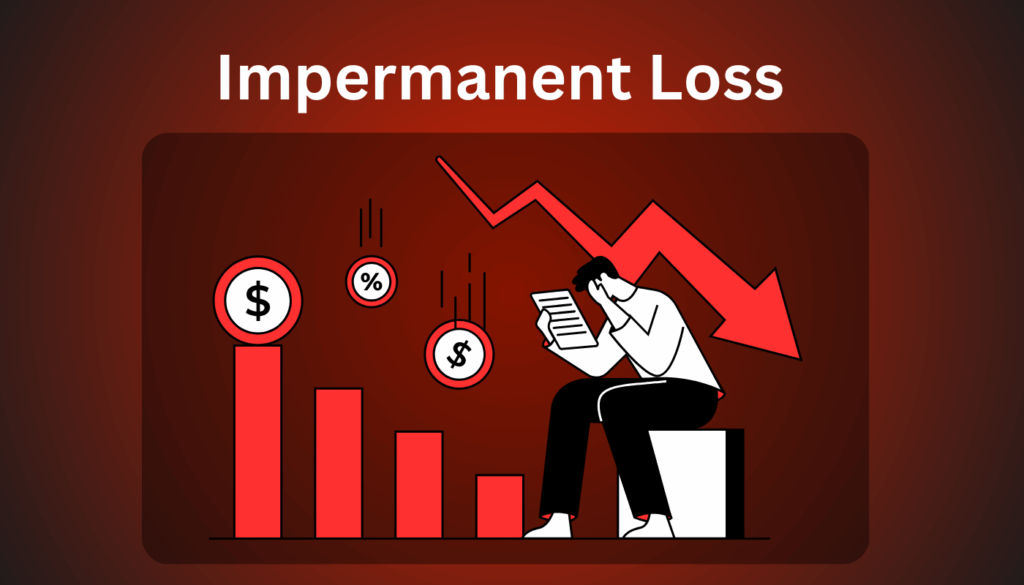
If you’re exploring the world of DeFi and considering becoming a liquidity provider (LP) on a decentralized exchange (DEX), you’ll inevitably encounter something called impermanent loss (IL). It sounds intimidating at first—but it’s not a trap, just math.
When prices shift, the automated market maker (AMM) rebalances your position in a way that can make you worse off than if you’d simply held the tokens. This article breaks it down clearly with numbers, logic, and practical strategies to help you navigate IL like a pro.
TL;DR
- Impermanent loss (IL) is the underperformance of an LP position versus HODLing when token prices diverge from the original entry ratio.
- It’s «impermanent» only if prices revert to the entry ratio before you withdraw—otherwise, the loss becomes real.
- Fees and incentives may offset IL. Whether LPing is profitable depends on volume × fee tier versus volatility.
- Stable/pegged pairs (like USDC/DAI or stETH/ETH) generally yield lower IL. Volatile pairs (like ETH/USDC) result in more.
How a 50/50 Pool Works
Most traditional AMMs, like Uniswap v2, follow the constant product formula:
x · y = k
Where x and y are the reserves of two tokens in the pool. As external prices shift, arbitrageurs trade against the pool to realign it. Your LP tokens represent a slice of that pool—so when it rebalances, your token mix changes too.
- You deposit tokens in a 50/50 value ratio.
- Traders pay swap fees (typically 0.05%–0.30%), which go to LPs.
- As prices move, the pool adjusts—your position leans toward the underperforming token.
Clean Example: ETH Doubles
Let’s say you provide liquidity to an ETH–USDC pool.
- Entry price: 1 ETH = $1,000
- Deposit: 1 ETH + 1,000 USDC = $2,000 total
Later, ETH climbs to $2,000.
If you held your tokens:
- 1 ETH = $2,000
- 1,000 USDC = $1,000
- Total: $3,000
If you LP’d:
- Your position rebalances to ~0.7071 ETH + 1,414.2 USDC
- Value = (0.7071 × 2,000) + 1,414.2 = $2,828.4
Impermanent loss = $3,000 − $2,828.4 = −$171.6 (~−5.72%)
Symmetry Check: ETH Halves
Same entry, but ETH falls to $500.
HODL:
- 1 ETH = $500
- 1,000 USDC = $1,000
- Total: $1,500
LP:
- You now hold ~1.4142 ETH + 707.1 USDC
- Value = (1.4142 × 500) + 707.1 = $1,414.2
IL = $1,500 − $1,414.2 = −$85.8 (~−5.72%)
The takeaway? IL depends on divergence, not direction. A 2× rise and a 50% drop both create roughly the same IL.
The Quick IL Formula
Let P = new price ÷ original price. For 50/50 pools, the IL formula is:
IL = (2 × √P) / (1 + P) − 1
| Price Change | P | IL (%) |
|---|---|---|
| −50% | 0.5 | −5.72% |
| +100% | 2.0 | −5.72% |
| −75% | 0.25 | −20.00% |
| +300% | 4.0 | −20.00% |
| +900% | 10.0 | −25.84% |
The greater the price deviation from your entry point, the deeper the IL.
When Fees Beat IL
LPs earn fees with every trade in the pool. If your earned fees exceed your IL, you still walk away with a profit.
Quick example:
- Pool TVL: $100M
- Daily volume: $10M
- Fee tier: 0.30% → $30K/day in fees
- Your share: 2% → $600/day
From our earlier ETH double example, IL = $171.6. So, one day of fees covers it—as long as volume remains strong and incentives don’t dry up.
👉 LPing is a race between fee generation and price divergence.

Beyond 50/50: Smarter Pool Designs
- Stable-swap pools (e.g., USDC/DAI): Very low IL as long as the peg holds. IL only shows up if one asset depegs.
- Weighted pools (e.g., 80/20): Reduce IL for the dominant asset, at the cost of earning slightly fewer fees per dollar.
- Concentrated liquidity (Uniswap v3): LPs choose a price range. Inside it, you earn high fees; outside it, you go inactive or one-sided—and IL can spike.
Managing IL in Real Life
Best practices:
- Start small, and track:
→Net LP = Fees + Incentives − IL − Gas - Use high-volume, audited protocols.
- For v3, begin with wide price ranges or stable pairs.
- Rebalance or exit if volatility increases and IL surpasses expected fees.
Avoid:
- Chasing high APR without checking how rewards are distributed.
- Ignoring LPs for months in volatile pairs.
- Neglecting contract risk and wallet security.
Realistic Scenario: IL vs Fee Yield
- Entry: 1 ETH = $1,000
- Deposit: $10K (5 ETH + 5K USDC)
- ETH rises to $1,300 over 2 weeks
- Volume = 15% of TVL
- Fee tier = 0.20%
- Pool share = 1%
14-day fee estimate: ~$2,100
IL at +30%: ~−1.3% → −$130
Net: +$1,970 in this example.
Fees often outperform moderate IL in healthy, high-volume pools.
Common Myths
- “IL only happens if the price drops.” → ❌ No, divergence in any direction triggers IL.
- “It’s impermanent, so it doesn’t count.” → ❌ Not if you withdraw while prices are still diverged.
- “Single-sided LP means no IL.” → ❌ Not really—some protocols abstract it, but economic IL still applies.
FAQs
How do I assess a pool quickly?
Estimate your fee yield and test against ±25–50% price moves for IL.
Do fees compound?
Yes. They increase your pool share and slightly shift your exposure over time.
Where should I start?
Stablecoin pools, audited protocols, small size, wide ranges. Then scale.
Final Thoughts
Impermanent loss isn’t a design flaw—it’s the cost of being a liquidity provider in AMMs. You’re stepping in as the market itself, and the trade-off is exposure to price rebalancing in exchange for fees and yield.
Understand the math. Know your risk. Compare potential fees vs divergence scenarios. If you track your net performance and adjust actively, impermanent loss becomes just another manageable variable in your DeFi strategy—not something to fear.